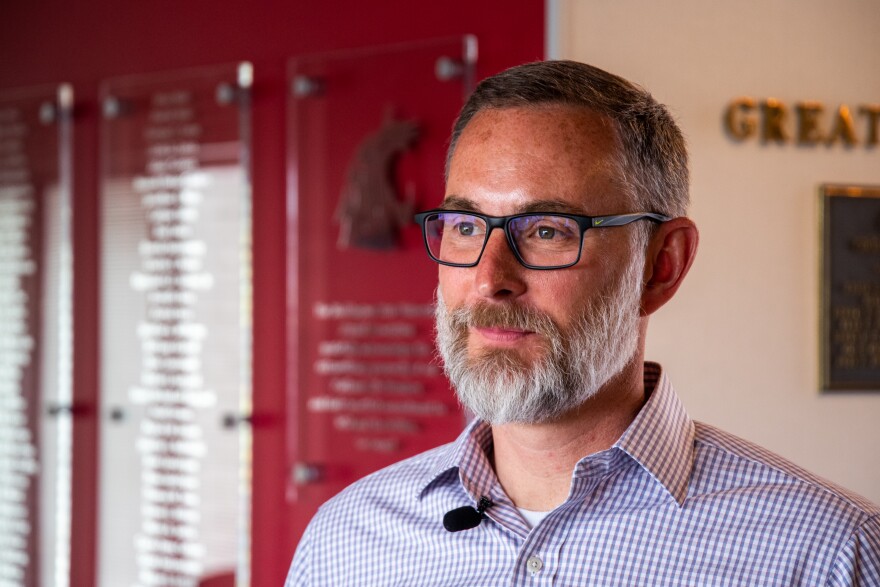At a barbecue on campus last week, flames licked a set of sausage links as scientist Blake Foraker worked on the perfect grill marks.
“We smoked these during the cooking process, so that’s where you see the nice mahogany brown,” Foraker said, as the grill sizzled.
But these aren’t your average pork sausages.
With permission from the Food and Drug Administration, WSU researchers made them from pigs whose DNA has been changed. While the FDA has approved gene-edited animals before, this is the first time the federal agency has authorized a university to conduct this type of research.
Jon Oatley, a professor of molecular biosciences at WSU and the lead researcher on the project, used a tool called CRISPR on five pigs.

“Genome editing with tools like CRISPR can create changes in DNA that [...] can and oftentimes do arise in nature,” Oatley said.
Basically, it’s a shortcut. Oatley said CRISPR can take years off traditional selective breeding. And the ultimate goal is much bigger than grilling a few German-style sausages: Oatley said this type of bioengineering could help tackle world hunger and preserve endangered species, especially as the climate continues to change.
“The conditions that we're asking food animals to thrive in, to be more resilient in, is much more difficult, whether it's a reduction in the availability of water, or reduction in availability of feed stuffs, pasture land, grazing land, increasing heat, or increasing cold,” he said.
This process could produce livestock that can thrive in harsh conditions – and still provide adequate nutrition for people.
In typical breeding, Oatley said, a stud passes along specific genetic traits to its offspring. “The problem is only one male can be available for breeding purposes,” Oatley said. But with CRISPR, Oatley is making more males who can pass along desirable traits.
That involves snipping out a male fertility gene to make the pigs temporarily sterile. Oatley calls them surrogate sires.
Then, the scientists take the stem cells from the main breeding pig and put them into the sterile pigs, allowing them to produce the same sperm as the boar.
“And now you have 10 males all making the sperm carrying the elite DNA of that one male,” Oatly said. That means more swine that can better survive in harsher conditions – or whichever trait breeders want to pass along.
Charles Long studies CRISPR at Texas A&M University. He wasn’t involved in Oatley’s research. He described the project as “cutting edge.”
“The pace where we can make genetic progress using these new technologies of gene editing and genome engineering is vastly superior to the old fashioned, classical way,” Long said.
He added that the FDA’s current approval process is slowing down research. Instead, the U.S. Department of Agriculture should regulate this type of research, Long said, noting that the USDA already regulates gene-edited plants.
Lydia Garas, a biologist at Highline College in Des Moines, Wash., agrees that the process should go faster.
Gene editing may sound scary. But Garas says it’s more ethical than traditional breeding, where bad traits can get passed along. Think pugs with trouble breathing.
“We can improve the life, the health, the well being of animals that are part of agriculture, and also we can reduce the number of animals that are producing a certain amount of food and the number of animals that are sacrificed in this process,” Garas said.
Genome editing is not the same as producing genetically modified organisms, or GMOs. Garas said it’s a new tool to speed up a very old process – and make it more accurate. And she said it’s safe to eat. Her advice: “To not be afraid of progress and to not be so skeptical of science and the intention of scientists,” Garas said.
In addition to these five pigs in Washington, the FDA has also approved two gene-edited cattle from a Minnesota-based company. Researchers modified their DNA so that they’d be able to better tolerate hot weather.

At WSU, the FDA’s approval was limited to five pigs. Their offspring aren’t gene edited and haven’t received approval yet.
So, what does the pork actually taste like?
At the barbecue last week, reporters, students and faculty lined up to try it. The verdict: smoky, and mildly salty. A good snap to the casings. Just like regular pork.
Oatley said the taste test was more than a decade in the making.
“I think that this technology of using CRISPRs and other gene editing strategies, is the future of how we need to feed people,” he said.
The university is also studying CRISPR gene editing on cattle and sheep, and a goat study wrapped up last year. If all goes as planned, Oatley said gene-edited meats could be mass produced for human consumption in 10 years.


